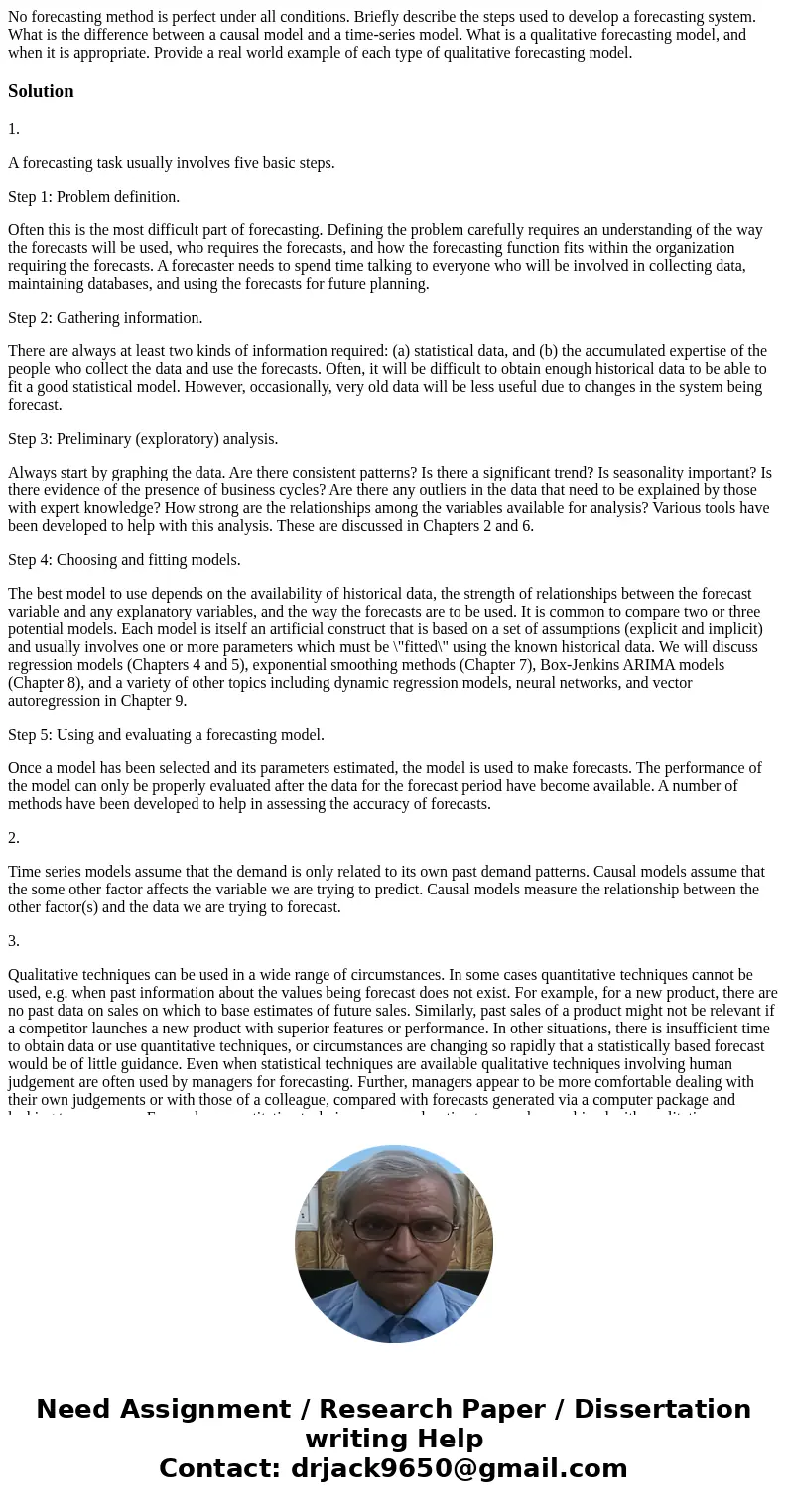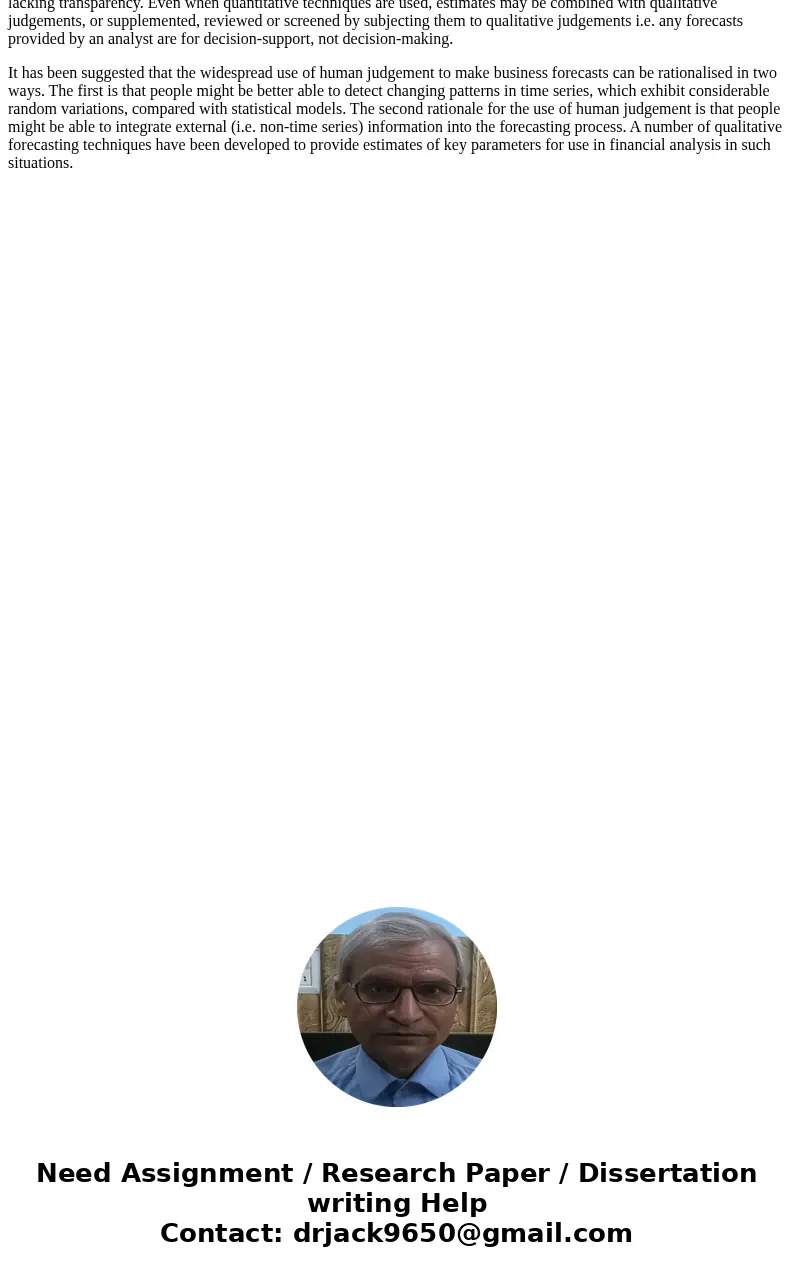No forecasting method is perfect under all conditions Briefl
No forecasting method is perfect under all conditions. Briefly describe the steps used to develop a forecasting system. What is the difference between a causal model and a time-series model. What is a qualitative forecasting model, and when it is appropriate. Provide a real world example of each type of qualitative forecasting model.
Solution
1.
A forecasting task usually involves five basic steps.
Step 1: Problem definition.
Often this is the most difficult part of forecasting. Defining the problem carefully requires an understanding of the way the forecasts will be used, who requires the forecasts, and how the forecasting function fits within the organization requiring the forecasts. A forecaster needs to spend time talking to everyone who will be involved in collecting data, maintaining databases, and using the forecasts for future planning.
Step 2: Gathering information.
There are always at least two kinds of information required: (a) statistical data, and (b) the accumulated expertise of the people who collect the data and use the forecasts. Often, it will be difficult to obtain enough historical data to be able to fit a good statistical model. However, occasionally, very old data will be less useful due to changes in the system being forecast.
Step 3: Preliminary (exploratory) analysis.
Always start by graphing the data. Are there consistent patterns? Is there a significant trend? Is seasonality important? Is there evidence of the presence of business cycles? Are there any outliers in the data that need to be explained by those with expert knowledge? How strong are the relationships among the variables available for analysis? Various tools have been developed to help with this analysis. These are discussed in Chapters 2 and 6.
Step 4: Choosing and fitting models.
The best model to use depends on the availability of historical data, the strength of relationships between the forecast variable and any explanatory variables, and the way the forecasts are to be used. It is common to compare two or three potential models. Each model is itself an artificial construct that is based on a set of assumptions (explicit and implicit) and usually involves one or more parameters which must be \"fitted\" using the known historical data. We will discuss regression models (Chapters 4 and 5), exponential smoothing methods (Chapter 7), Box-Jenkins ARIMA models (Chapter 8), and a variety of other topics including dynamic regression models, neural networks, and vector autoregression in Chapter 9.
Step 5: Using and evaluating a forecasting model.
Once a model has been selected and its parameters estimated, the model is used to make forecasts. The performance of the model can only be properly evaluated after the data for the forecast period have become available. A number of methods have been developed to help in assessing the accuracy of forecasts.
2.
Time series models assume that the demand is only related to its own past demand patterns. Causal models assume that the some other factor affects the variable we are trying to predict. Causal models measure the relationship between the other factor(s) and the data we are trying to forecast.
3.
Qualitative techniques can be used in a wide range of circumstances. In some cases quantitative techniques cannot be used, e.g. when past information about the values being forecast does not exist. For example, for a new product, there are no past data on sales on which to base estimates of future sales. Similarly, past sales of a product might not be relevant if a competitor launches a new product with superior features or performance. In other situations, there is insufficient time to obtain data or use quantitative techniques, or circumstances are changing so rapidly that a statistically based forecast would be of little guidance. Even when statistical techniques are available qualitative techniques involving human judgement are often used by managers for forecasting. Further, managers appear to be more comfortable dealing with their own judgements or with those of a colleague, compared with forecasts generated via a computer package and lacking transparency. Even when quantitative techniques are used, estimates may be combined with qualitative judgements, or supplemented, reviewed or screened by subjecting them to qualitative judgements i.e. any forecasts provided by an analyst are for decision-support, not decision-making.
It has been suggested that the widespread use of human judgement to make business forecasts can be rationalised in two ways. The first is that people might be better able to detect changing patterns in time series, which exhibit considerable random variations, compared with statistical models. The second rationale for the use of human judgement is that people might be able to integrate external (i.e. non-time series) information into the forecasting process. A number of qualitative forecasting techniques have been developed to provide estimates of key parameters for use in financial analysis in such situations.


 Homework Sourse
Homework Sourse